
Are your marketing campaigns driving awareness or just collecting leads? And, are those clicks converting into pipeline and revenue? Well! It is not just you. A recent Gartner survey found that 77% of B2B buyers consider their purchasing process to be complex.
It means that generic lead generation tactics will not work well in recent times. Hence, you need to adopt the B2B demand generation trend to win in longer and more complex sales cycles.
For it, you need a strategy that builds trust, drives engagement across every stage of the funnel, and creates demand before it even exists. This guide will show you exactly how to use demand generation to turn attention into action.

B2B demand generation is a digital marketing strategy that creates product or service interest among buyers without forcing them to buy it.
Hubspot puts it simply:
“Demand generation helps you tap into new markets, build interest in your solution, and engage your existing customers.”
It combines marketing and sales to build trust, attract the right audience, and turn curiosity into long-term customers.
You can consider demand generation as planting seeds. This way, you can build trust through content and thought leadership that guides decision-makers from what they need to solve a problem to purchase your product to solve that problem.
So, if your funnel is filled with unqualified leads that never convert, then the problem is not traffic. It is your B2B demand generation strategy that will help you align your brand with the buyer’s intent before they even know they need you.
You need to understand that B2B buyers prefer exploring for themselves instead of being directly sold to.
A study by Worldwide Business Research proves that 70% of B2B buyers research online before actually contacting sales. Thus, your brand needs to appear before the conversation even starts.
The benefit of B2B demand generation is not limited, though. With a strong strategy in place, you can also:
With that said, B2B demand generation bridges the gap between marketing and sales. You can connect with qualified leads actively looking for your products or services.
Both the terms “demand generation” and “lead generation” are used like they are interchangeable, but they are not. Although they are connected, they play completely different roles in your funnel.
B2B demand generation helps to generate interest. It is the top-of-the-funnel strategy that gets your brand in front of the right people. This strategy assists you in reaching the business long before they are even thinking about booking a demo or talking to sales. It builds awareness, positions your brand as a solution to a problem, and educates your audience. Some of the ways to demand generation are blogs, podcasts, community engagement, and thought leadership.
On the other hand, lead generation takes that awareness and turns it into action. It is when a customer says, “I am interested – tell me more.” This is where you capture details through a webinar registration, whitepaper download, or contact form.
The key difference between B2B demand generation vs lead generation is that:
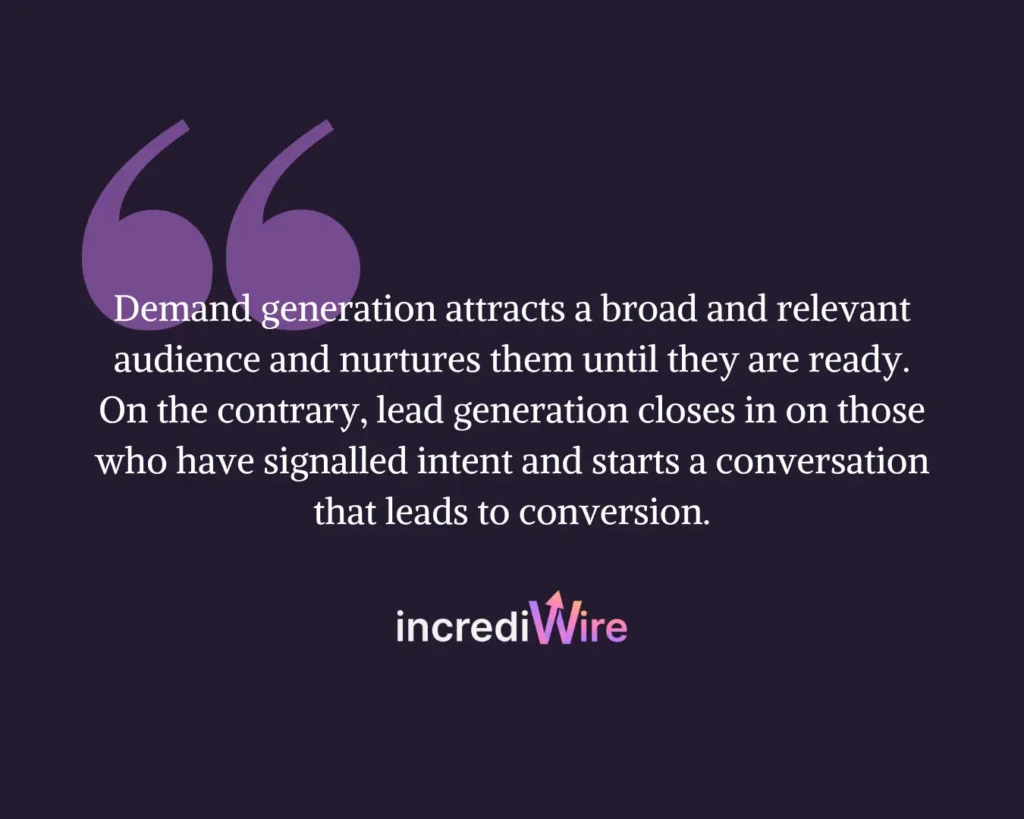
Hence, you cannot afford to ignore demand generation. If people don’t know about your brand, your product, or the problem you solve, they will not become leads. And if you push them for conversions before interest is built, there is a high chance that you will waste your ad budget and frustrate your sales team.
The truth is that B2B demand generation fills the pipeline with quality, while lead generation moves qualified prospects down the funnel.
You do not have to choose one over the other. If you want to win, you should align both these approaches into your strategy.
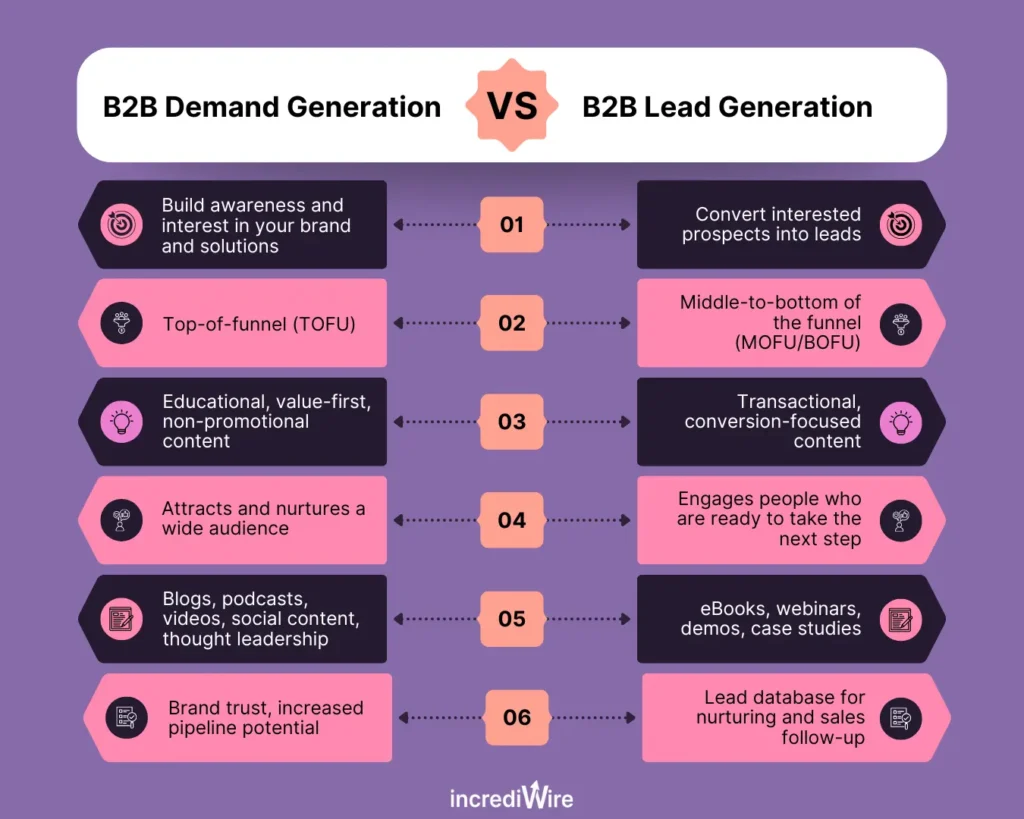
Traditional lead generation is often dependent on cold outreach to generate leads, such as emailing or calling prospects who have not shown interest. If someone picks up or responds, it doesn’t mean that they are ready to buy. And that is exactly why the B2B demand generation funnel is important.
This funnel is a visual roadmap of the journey your potential buyers go through from discovering your brand to becoming your customer. It is a structured journey that turns brand awareness into real revenue. Moreover, it is a system that brings in the right people, educates them, builds trust, and turns them into sales-qualified leads (SQLs).
Gartner’s research says that buyers spend just 17% of the buying process talking to sales reps. It means marketing drives 83% of the buying journey, so you must know about the funnel.
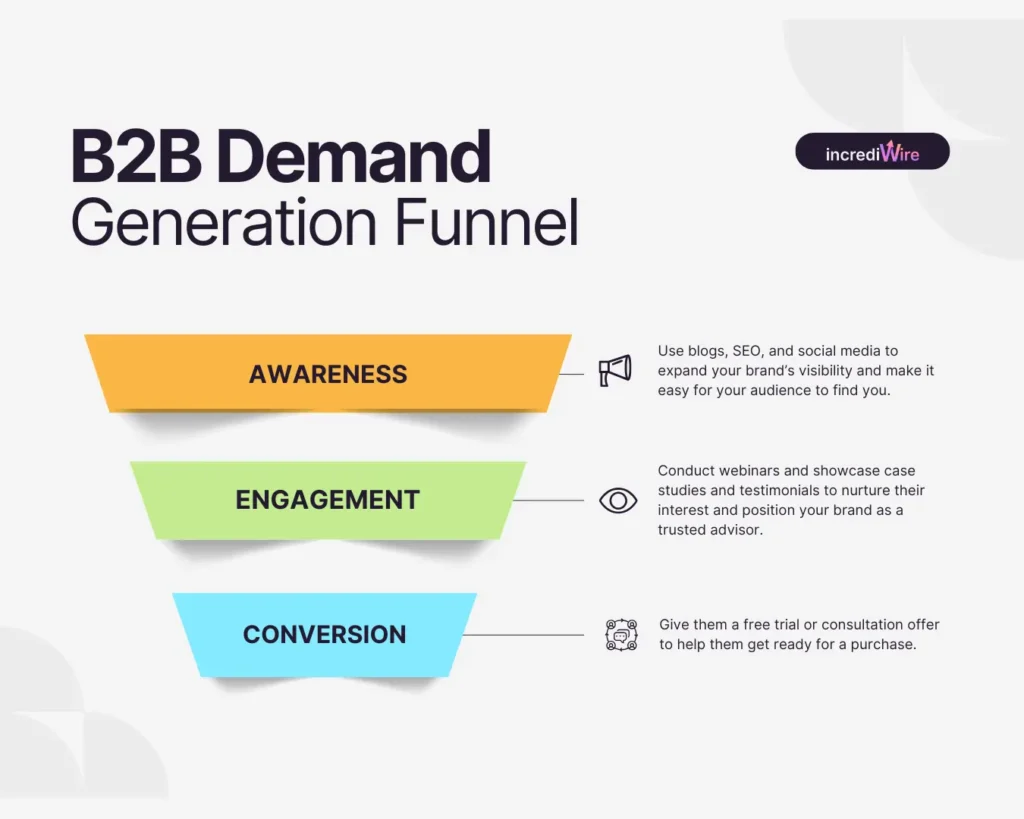
Let’s look at the funnel in detail:
1. Top of the Funnel (Awareness):
It is the wide net in the entire demand generation funnel. At this stage, your work is to spark curiosity and educate your target audience. Content like blog posts, podcast episodes, SEO-driven guides, and social media helps introduce your audience to a problem they may not even realize that they have. You must note that you are not selling here, but showing up where your customers spend most of their time.
2. Middle of the Funnel (Engagement):
After the buyer is aware of the problem, they might be looking for solutions. This is where your case studies, webinars, lead magnets, and comparison content can help. Here, you are building credibility and positioning yourself as the answer to their problem.
3. Bottom of the Funnel (Conversion):
Now, your audience is warm. They have engaged, trust your brand, and are ready for more. This is where you use product demos, free trials, ROI calculators, and testimonials to drive conversions.
Each stage in the B2B demand generation funnel must work hand in hand to move leads seamlessly down the sales pipeline. You are required to build value at every touchpoint.
Thus, if you don’t have content mapped at each stage, you are leaving a huge chunk of money for your competitors.
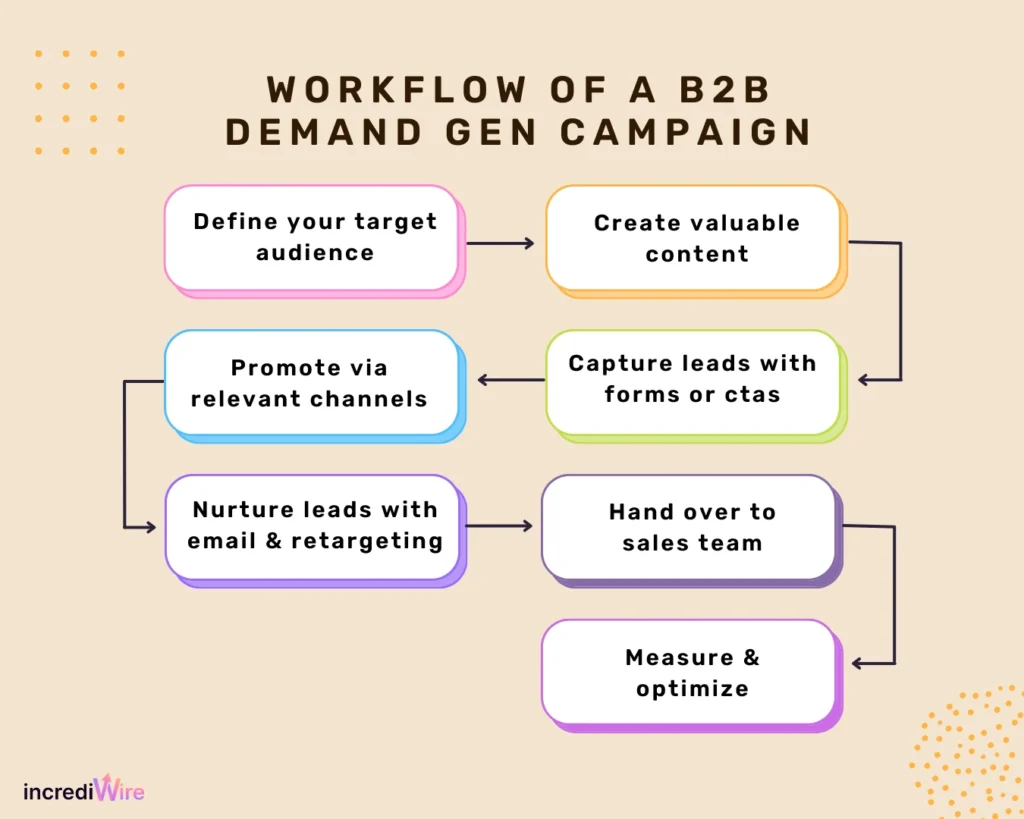
Now that you have understood what an actual B2B demand generation buyer journey looks like, it is time to start getting the attention of your B2B audience.
The following are some of the tactics that you can use to attract the right audience, build trust, and turn interest into a pipeline:
1. Create Content That Educates Before It Sells:
Creating content and hoping that people will care is not going to work anymore. You need to create painkiller content, like blogs, guides, videos, and podcasts that solve real problems. Research by McKinsey & Company shows that 71% of buyers want personalized content tailored to their pain points.
So, rather than selling forcibly, your content should tell your audience, “We understand you.”
2. Dark Social is the New Word of Mouth:
Platforms like LinkedIn, Slack communities, and even private DMs are some places where decision-makers are buying. Although traditional attribution might be missing, words spread fast in these channels. Thus, you should share free insights, hot takes, and value-packed carousels where your audience already lives.
3. Experiment with Paid Distribution:
A B2B demand generation campaign without paid promotion is like a car without fuel. You can use paid social media such as LinkedIn and Meta, intent platforms like 6sense or Demandbase, and even podcast sponsorships to develop high-performing content.
When you use both organic and paid tactics, you can see 2x better lead quality.
4. Create a Lead Scoring Framework:
All the leads are not equal. You need a lead scoring model that identifies which prospects are ready for sales and which need more nurturing. This lets your sales team focus on the high-intent opportunities while marketing continues to warm up the rest.
5. Do Not Gate Everything:
It is true that gated content has a place, but ungated content builds trust faster. You should only gate content when there is a true value in exchange, like detailed reports, calculators, or on-demand demos.
A successful B2B demand generation plan should balance short-term wins with long-term brand building. You can make your strategy effective by measuring what is working, doubling down on what converts, and always staying a step ahead of your buyer’s journey.
It is rightly said that: Attention is earned and demand is generated.
After you have built your content, launched your ads, and optimized your emails, the next big thing is to check whether it is working.
It is the time when too many B2B marketers fall into the trap of chasing vanity metrics, such as likes, shares, and comments.
Yes, they look great in a slide deck. But if those numbers don’t contribute to your sales pipeline, they are a waste of time and resources.
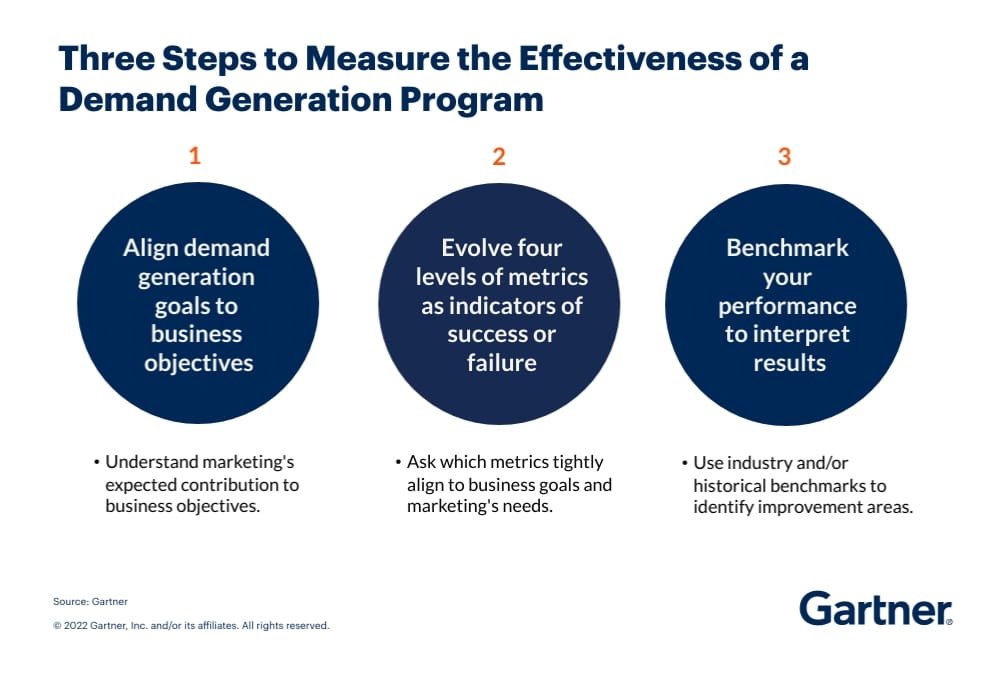
Here are the core metrics that separate high-performing B2B demand generation campaigns from the rest:
Besides tracking metrics, it is equally important to test.
You can A/B test landing pages, CTAs, headlines, ads, and content types to see what works best. Google Optimize, Hubspot, or Optimizely are some best tools that you can use.
For example, Hubspot tested the homepage of Hubspot Academy to see how changes affected user behaviour and conversions. This helped them to choose the variant that outperformed the other variant by 6%.
Thus, you must know that B2B digital marketing campaigns are not “set it and forget it.” They are living systems that require continuous tweaking. So, use your analytics as a feedback loop and optimize relentlessly.
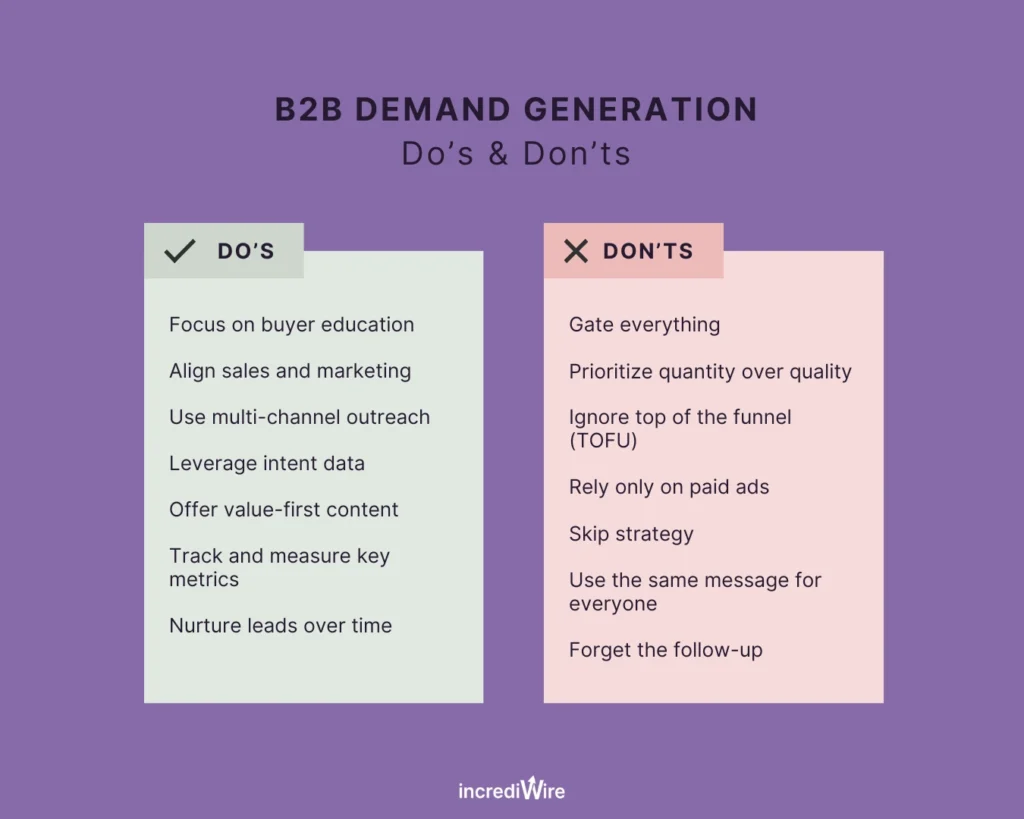
B2B demand generation can be a transformative breakthrough for your B2B brand or a black hole for your marketing budget. The difference lies in the execution, and most brands (even the big ones) still make basic mistakes. Some of them include:
1. Focusing Only on Short-Term Lead Generation:
It is true that chasing quick wins like form fills and demo requests feels good in a spreadsheet. But if you are only optimizing for leads today, you are ignoring 95% of your potential buyers who are not ready yet. Long-term brand building is more effective for sustained growth than constant lead acquisition. Hence, B2B demand generation is about visibility, trust, and timing.
2. Not Aligning Sales and Marketing Teams:
When your sales team does not know about what content prospects have seen or which campaigns they have engaged with, you miss conversion opportunities. Businesses that align on buyer personas, messaging, and KPIs achieve 36% higher customer retention and 38% higher sales.
3. Neglecting Retargeting and Nurturing Strategies:
Visitors who bounce after their first visit are not considered lost; chances are that they are just not ready. The best way to address this problem is by setting up retargeting ads, email drips, and sequential content to re-engage and nurture. These strategies will help you stay on top of their minds without being too pushy.
4. Ignoring Data-Driven Decision-Making:
If you are not learning from your data, you are stuck guessing. Are your ads bringing the right people? Are your emails getting opened? If you do not know the answer to these questions, you cannot grow. Successful brands experiment, measure, and optimize their B2B demand generation strategy regularly.
With the advancement in AI, B2B marketing is evolving at a fast rate. If you are running demand gen strategies the way you did three years ago, you are already behind.
Today, top-performing B2B brands engineer it using predictive models, AI, and automation to scale smarter and faster.
Here are some of the advanced frameworks to bring next-level thinking into your B2B demand generation efforts:
The predictive demand generation model is Demand Gen 2.0.
It uses historical data, intent signals, and buying patterns to forecast who is most likely to become a customer and when. This way, it can improve marketing-generated lead conversion.
Here is how it works:
Through these insights, you can score accounts accurately and create highly targeted campaigns.
Instead of bombarding your audience with generic messages, you can prioritize warm and high-fit accounts with tailored content.
If you leverage AI into your B2B demand generation efforts, you can have a competitive edge.
Modern marketing campaigns use intelligent tools to predict behaviour, personalize experiences, and automate repetitive tasks. And, it can lead to better results at a much faster rate.
Harvard Business Review reports that AI-driven marketing can increase lead generation efficiency by up to 50%. However, you should do things better rather than faster.
Besides this, AI and automation can also provide the following advantages:
This is how B2B demand generation teams create seamless journeys that drive pipeline growth. But you need to make sure that your foundation is strong with clean data, an integrated tech stack, and a clear view of the customer journey.
Here are the companies that generated serious pipelines and revenue through smart and scalable B2B demand generation practices:

Monday.com is a popular work operating system that made its way with a laser-focused B2B SaaS demand generation strategy. Launched in 2014, they have grown into a $120M+ revenue machine with 75% quarterly revenue growth.
To achieve this, they implemented a data-driven and diverse content marketing strategy in SaaS.
Therefore, Monday.com shows that great B2B content marketing is about publishing smart, strategic, and segmented content to drive real results.
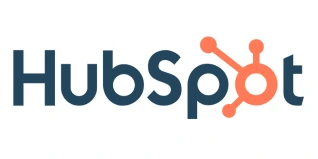
Hubspot is a global SaaS marketing company that revolutionized content marketing with inbound at its core. They used this strategy to build a $1B+ brand trusted by marketers worldwide.
Some of the razor-sharp content marketing executions that helped them achieve this figure are:
Hubspot proves that when you educate first, segment smartly, and repurpose your content, you attract more and more leads to your business.
The simple answer to this question is: Start small, but smartly.
You can begin by identifying your ICP (ideal customer profile), auditing your current funnel, and setting clear B2B demand gen goals. From there, you can build out your content ecosystem using SEO, LinkedIn thought leadership, webinars, email nurturing, and paid distribution. This way, you can solve their problem and become a go-to expert in your niche.
If you want to implement these strategies into your business, you can choose Incrediwire. We are your growth partner who can help you run effective B2B demand generation campaigns. From strategy to execution, we integrate systems, content, targeting, and automation to generate actual demand.
So, stop waiting and book your FREE strategy call with Incrediwire today!
Table of Contents
